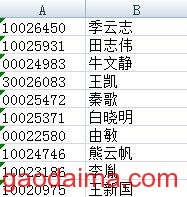mysql常用命令集锦
一、DCL语句(数据控制语句)
1、授权远程访问,针对IP和用户、DB的 grant {privilege list} on {dbname}.* to ‘{user}’@'{ip}’ identified by ‘{pwd}’ with grant option ex: grant all privilege on *.* to ‘root’@’%’ identified by ‘***’ with grant option; — %代表所有IP grant all privileges on *.* to ‘exam’@’192.168.0.%’ identified by ‘***’ with grant option; — 指定IP段被授权所有权限,用指定账户/密码 注意事项: mysql.user表中,如果没有localhost/127.0.0.1这样的记录(默认会产生的),则通过ssh的连接,也会失败,如果是自己机器上的库,因为默认是localhost的二、DDL语句(数据定义语句)
1 、create user {usrname} identified by ‘{pwd}’;2、create database {dbname} character set ‘utf8’ collate ‘utf8_general_ci’;三、DML语句(数据操作语句)
命令行下具体用法如下: mysqldump -u用戶名 -p密码 -d/-t 數據库名 表名 脚本名; (-d表示结构,-t表示数据, 都没有表示结构和数据)
1、导出數據库為dbname的表结构(其中用戶名為root,密码為dbpasswd,生成的脚本名為db.sql)
mysqldump -uroot -pdbpasswd -d dbname >db.sql;
2、导出數據库為dbname某张表(test)结构
mysqldump -uroot -pdbpasswd -d dbname test>db.sql;
3、到处数据库的所有对象,不包括数据
mysqldump -uroot -pdbpasswd -R –no-data dbname >db.sql;
4、完整导出数据库(包括表对象、PROC、FUNC、TRIGGER、数据)
mysqldump -uroot -pdbpasswd -R dbname >db_all.sql;
5、完整导入数据库(包括表对象、PROC、FUNC、TRIGGER、数据)
source db_all.sql; — 有人说用 mysqldump -uroot -pdbpasswd dbname <db_all.sql;可以,但我试了,总是有问题,不知何故。
 b 按表结构构造后数据
b 按表结构构造后数据 E列就是构造出来的SQL, 然后可直接copy到txt中,并保存成.sql文件,通过source 导入到库中。 E列写法: =”insert into user_info(recordid,companyid,department,app_sys_ids,userjid,userid,name,creator,createdate) values(default,’ZTE’,114,’1,2′,”&”‘”&TRIM(A1052)&”@moaservice.zte.com.cn’,”&C1052&”,”&D1052&”,’admin’,now());”生成的SQL,以第一行为例: insert into user_info(recordid,companyid,department,app_sys_ids,userjid,userid,name,creator,createdate) values(default,’ZTE’,114,’1,2′,’[email protected]’,’10009240′,’余昆’,’admin’,now()); 四、注释语句mysql下支持3种注释,#,/**/,– , 最后一个– 必须后加一个空格,否则无效,这个不同于oracle,使用时应注意。 五、丢失root密码时,如何重置密码? mysqld_safe –skip-grant-tables& mysql -u root mysql
E列就是构造出来的SQL, 然后可直接copy到txt中,并保存成.sql文件,通过source 导入到库中。 E列写法: =”insert into user_info(recordid,companyid,department,app_sys_ids,userjid,userid,name,creator,createdate) values(default,’ZTE’,114,’1,2′,”&”‘”&TRIM(A1052)&”@moaservice.zte.com.cn’,”&C1052&”,”&D1052&”,’admin’,now());”生成的SQL,以第一行为例: insert into user_info(recordid,companyid,department,app_sys_ids,userjid,userid,name,creator,createdate) values(default,’ZTE’,114,’1,2′,’[email protected]’,’10009240′,’余昆’,’admin’,now()); 四、注释语句mysql下支持3种注释,#,/**/,– , 最后一个– 必须后加一个空格,否则无效,这个不同于oracle,使用时应注意。 五、丢失root密码时,如何重置密码? mysqld_safe –skip-grant-tables& mysql -u root mysqlmysql> UPDATE user SET password=PASSWORD(“new password”) WHERE user=’root’;
mysql> FLUSH PRIVILEGES;
六、windows下mysql的zip包如何安装?
解压mysql压缩包后,cmd到其解压后目录的bin目录下, 运行如下命令: mysqld -install, 即可将mysql安装成windows服务。
之后可将此服务设置成自启动, 或手工启动; 命令行启动/停止: net start mysql / net stop mysql
欢迎大家阅读《mysql常用命令汇总_mysql》,跪求各位点评,by 搞代码




